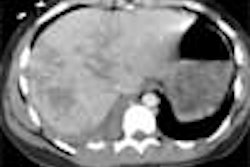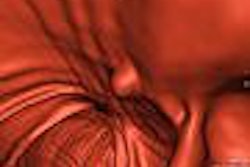Vasculopathy is the most frequent long-term cause of death in heart-transplant recipients, yet evaluating patients with invasive imaging like coronary angiography also carries significant risks. Fortunately, it appears that MDCT can now play a role.
A new study comparing the performance of 16-slice CT scans with traditional coronary angiography found excellent correlation in the findings, according to Dr. Gardar Sigurdsson from the Cleveland Clinic in Ohio.
Sigurdsson presented the findings at the RSNA meeting in Chicago last week, and won an RSNA research in training award for his presentation.
Around 40% of heart transplant patients die from coronary allograft vasculopathy, which differs from traditional coronary artery disease. It develops diffusely, starting with the smaller distal vessels.
"Due to the fact that this usually comes very quietly and patients don't have symptoms, we want to try to find this early," Sigurdsson noted in his presentation on Thursday. "Current practice in the U.S. is to use serial angiography, and also many centers will do intravascular ultrasound."
"Obviously these procedures will be invasive and lead to complications: strokes, heart attacks, bleeding, and death," Sigurdsson continued. "We clearly need a noninvasive alternative."
Sigurdsson and his co-investigators examined 32 transplant recipients who were also slated for coronary angiography within the next seven days. The patients had received heart transplants from as little as two months to as much as 12 years prior.
ECG-gated contrast-enhanced scans were performed at a rotation speed of 0.425 seconds, obtaining 0.8-mm slices. The heart rates of the patients ranged from 58 to 110 bps, and were generally higher than seen in other patient populations, Sigurdsson noted, but beta blockers were administered to less than 5% of the group.
Tissue Doppler was used to determine exactly which phase the heart was in during imaging. Eighteen percent of the time they couldn't see segment volume, he said, but "in general we saw most vessels in most patients."
The CT scanning had no significant effect on heart rates or creatinine levels, Sigurdsson said.
Out of 429 coronary segments analyzed, 120 (28%) were found to be abnormal by angiography and 99 (23%) by MDCT. The classification was concordant in 375 segments, or 87%.
The MDCT-derived percentage of luminal stenosis also showed an excellent correlation with the percentage derived by traditional angiography, Sigurdsson reported.
Overall, the sensitivity of MDCT was 94%, specificity was 99% and negative predictive value was 99%.
Only 25% of the stenoses were calcified plaques. "It may be our good results can be solely explained by the fact that our patients with stenosis had very few calcified plaques," Sigurdsson noted.
"CT appears to be both safe and feasible in transplant patients," Sigurdsson concluded. "It might be an acceptable alternative to conventional angiography," particularly in thinner patients with no premature ventricular contractions.
By Tracie L. Thompson
AuntMinnie.com staff writer
December 7, 2004
Related Reading
Ask questions to optimize MDCT protocols, July 11, 2003
Intravascular ultrasound safe for assessing CAD in cardiac transplant recipients, June 13, 2003
All-in-one CT protocol improves evaluation of potential living liver donors, August 12, 2002
Copyright © 2004 AuntMinnie.com



















